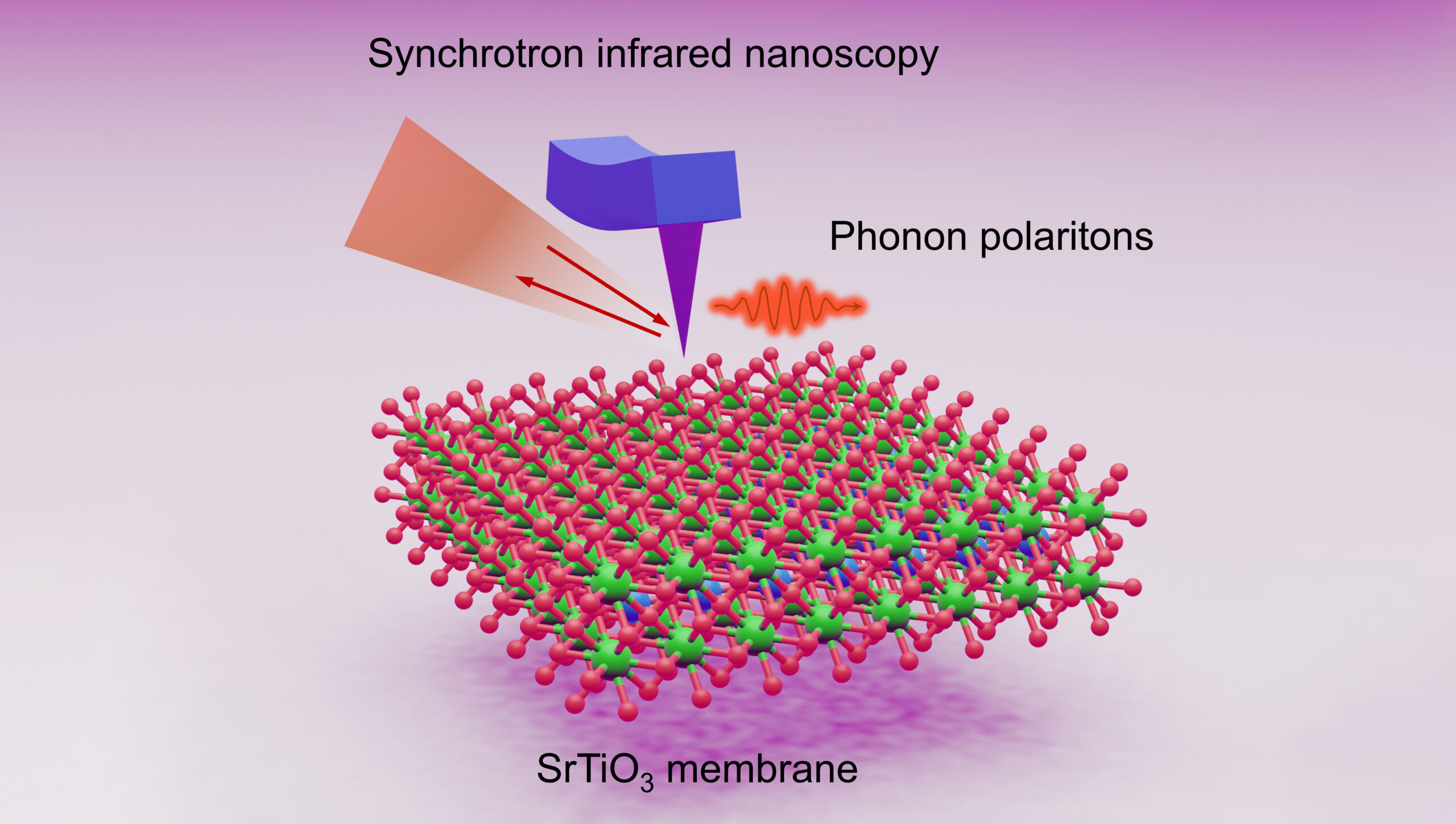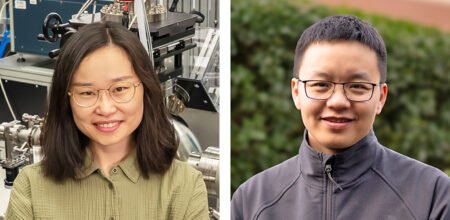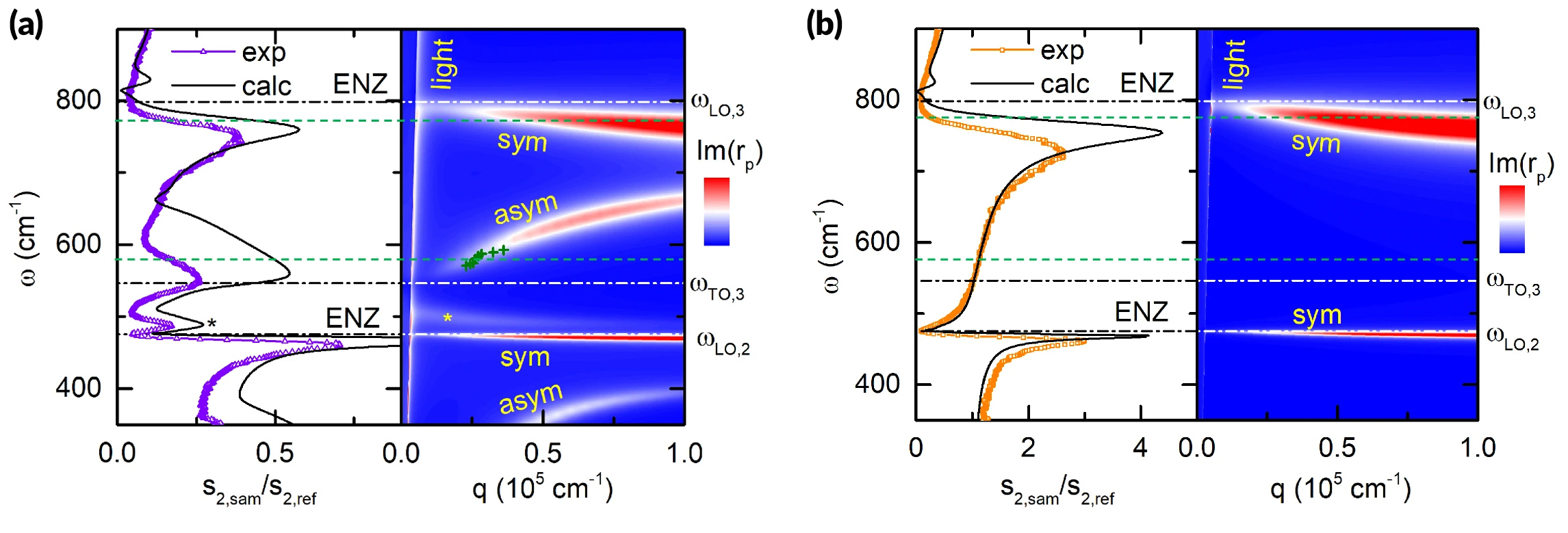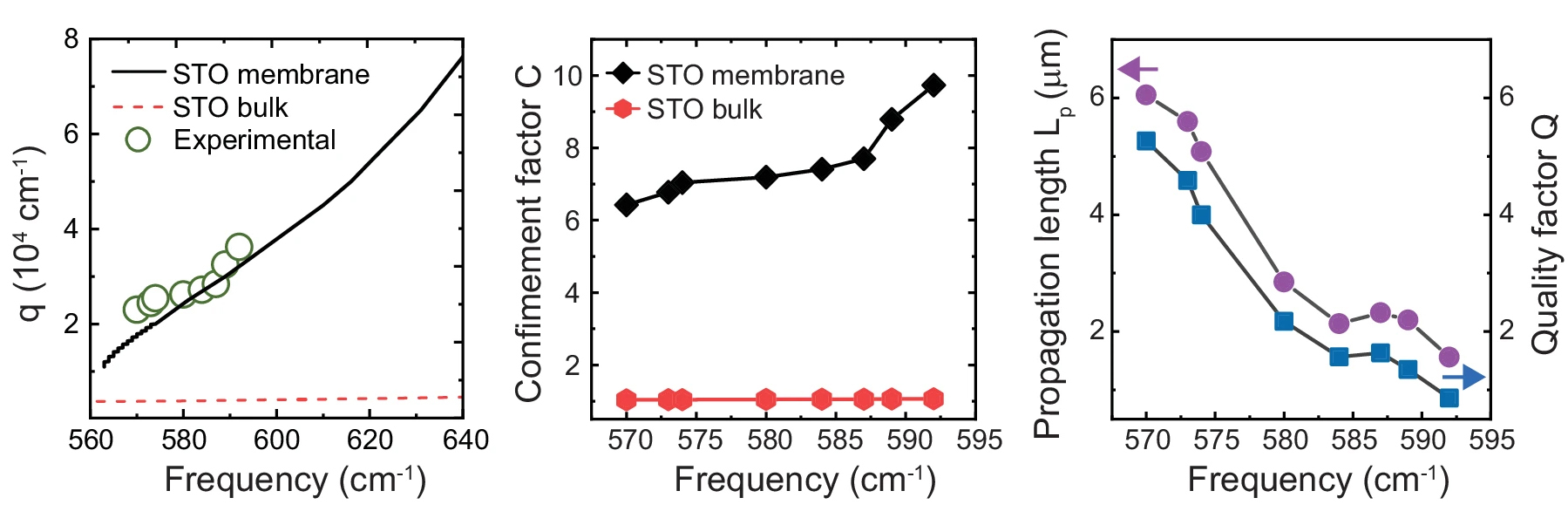SCIENTIFIC ACHIEVEMENT
Using the Advanced Light Source (ALS), researchers demonstrated a new way to confine, or “squeeze,” infrared light by coupling photons with phonons (lattice vibrations) within a certain type of thin film.
SIGNIFICANCE AND IMPACT
The work heralds a new class of optical materials for controlling infrared light, with potential applications in photonics, sensors, and microelectronic heat management.

A light squeeze
Researchers have demonstrated that thin films of strontium titanate (SrTiO3, or STO) can confine, or “squeeze,” infrared light 10 times more than its bulk form can—a finding that holds promise for next-generation microelectronic and photonic devices. While this unusual behavior had been theoretically predicted for STO membranes, it had not yet been experimentally observed.
The researchers took advantage of advances in the synthesis of freestanding, large-scale crystalline oxide membranes, then used a combination of infrared micro- and nanospectroscopy to observe how infrared light couples to lattice vibrations in the membranes. They found that the coupling produced hybrid vibrational and electromagnetic waves (phonon polaritons) in the material, with different modes characterized by highly compressed wavelengths or greatly enhanced fields inside the sample.
Transferable membranes
Theoretical studies have suggested that ultrathin STO and other perovskite membranes can host highly confined surface phonon polaritons (SPhPs) with good propagation quality. Other compounds may have higher figures of merit, but because they are typically manually exfoliated, their lateral size is constrained to the micrometer range, which limits their potential for large-scale device fabrication.

For this work, the researchers prepared single-crystal membranes of STO, grown on a substrate with a water-soluble buffer layer. When the buffer layer is dissolved, a millimeter-scale STO film just 100 nm thick is released and can be transferred onto arbitrary materials. This approach avoids the problem of lattice mismatches, which can lower membrane quality in heterostructures that are epitaxially grown. Here, the STO membrane was transferred onto a SiO2/Si substrate partially coated with gold, which allowed direct comparison of SPhP properties on metals versus insulators.
Symmetric-antisymmetric splitting
Using lab-based Fourier-transform infrared (FTIR) spectroscopy, the researchers were able to associate absorption peaks with what’s known as a Berreman mode, in which the normal component of the electric field inside the sample is strongly enhanced.
For further insights, the researchers used synchrotron infrared nanospectroscopy (SINS) at ALS Beamline 2.4 to probe the SPhPs with nanoscale resolution across a wide frequency range. The data revealed a splitting of the SPhP modes into symmetric and antisymmetric branches. These branches result from interactions between SPhPs at the top and bottom surfaces as the membrane thickness decreases. In the symmetric branch, the normal component of the electric field is greatly enhanced. In the antisymmetric branch, propagating SPhPs are highly confined (by a factor of 10 compared to the corresponding bulk mode). Notably, the antisymmetric mode is fully suppressed on the metallic substrate—an important observation for theory and applications. Theoretical modeling fully corroborates the experimental results.

A broader palette of properties
Finally, SINS scans across a sample edge allowed the researchers to extract from the data important SPhP parameters such as momentum, confinement factor, propagation length, and quality factor.
In general, the results open up a broad new class of complex oxide materials that, as transferable membranes, can be easily integrated with other photonic materials to generate SPhPs for light manipulation. The work expands scientists’ options for controlling infrared-wavelength light and establishes the enormous potential of transition-metal oxide membranes as building blocks for future long-wavelength nanophotonics.

Contact: Yin Liu
Researchers: R. Xu and Y. Liu (North Carolina State University); I. Crassee, A. Bercher, L. Korosec, C.W. Rischau, J. Teyssier, and A.B. Kuzmenko (University of Geneva, Switzerland); H.A. Bechtel and S.N. Gilbert Corder (ALS); Y. Zhou (University of Geneva, Switzerland, and Capital Normal University, China); K.J. Crust, Y. Lee, J. Li, and H.Y. Hwang (Stanford University and SLAC National Accelerator Laboratory); and J.A. Dionne (Stanford University).
Funding: National Science Foundation, North Carolina State University, State of North Carolina, Swiss National Science Foundation, and US Department of Energy (DOE), Office of Science, National Quantum Information Science Research Centers. Operation of the ALS and SLAC is supported by DOE, Office of Science, Basic Energy Sciences program.
Publication: R. Xu, I. Crassee, H.A. Bechtel, Y. Zhou, A. Bercher, L. Korosec, C.W. Rischau, J. Teyssier, K.J. Crust, Y. Lee, S.N. Gilbert Corder, J. Li, J.A. Dionne, H.Y. Hwang, A.B. Kuzmenko, and Y. Liu, “Highly confined epsilon-near-zero and surface phonon polaritons in SrTiO3 membranes,” Nat. Commun. 15, 4743 (2024), doi:10.1038/s41467-024-47917-x.
ALS SCIENCE HIGHLIGHT #510